Accreditation is the official recognition by third (independent) persons of the competence of a legal entity or individual in performing specific tasks. The presence of accreditation means that this person can guarantee to his clients the fulfillment of tasks in accordance with the requirements of accreditation standards.
Accreditation
This determination requires some explanation. Firstly, recognition by third parties means that these persons themselves are competent. Otherwise, the accreditation will be invalid. Secondly, the accreditation must be independent, i.e. these third parties cannot participate or influence the relationship between the person who received the accreditation and his clients. Thirdly, standards must be established to obtain accreditation. These standards include the types of activities for which accreditation is carried out, as well as the rules of accreditation.
Accreditation began to develop along with the establishment of mass industrial production, the emergence of standards and rules for the performance of work. The first "types" of accreditation in the modern sense appeared in the 19th century. The impulse for its development in the industrial sphere was the need to ensure the unity of the assessment and measurement results.
The participation of an independent third party was required in order to ensure trust between the manufacturer and the consumer of the product. The consumer and the manufacturer would trust this third party. Accreditation has become the main tool that ensures such trust. It gained a wider range of activities and began to be applied in almost all sectors of the economy over time.
Objectives of accreditation
Currently, accreditation is one of the tools for improving the quality and competitiveness of products and services at the level of individual sectors of the economy, individual states and the international level. Accreditation means that the company follows to certain standards of activity. If the level of these standards is high, then this increases the degree of trust in the organization.
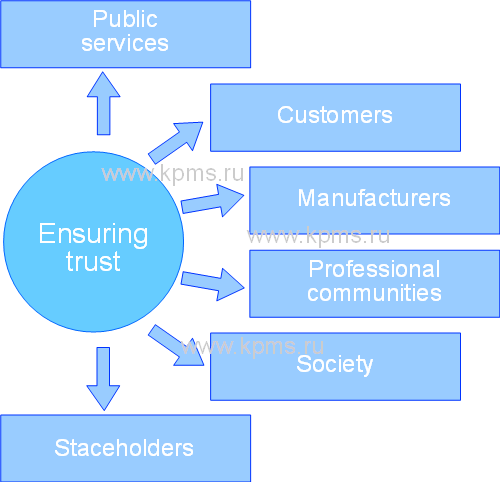
The main goal of accreditation is to increase the level of trust of all market participants: customers, manufacturers, professional communities, government services, experts and other interested parties. Accreditation indicates that the accredited organization (or person) has reached the appropriate level of development. It has reliable mechanisms to continuously improve the quality of the work and services that it provides.
In addition to the main one, there are other equally important goals of accreditation. All of them are associated with an increase in the level of trust between participants in economic activity.
The objectives of accreditation include:
- providing an external assessment of the quality of work or services performed. Accreditation is a process similar to the audit process. The result of this process is a conclusion about the applicant's compliance (or non-compliance) with the established quality criteria. If the applicant meets the quality criteria, he is accredited, and his work or services are recognized as corresponding to the established quality level;
- identification of organizations and individuals seeking to improve the quality of their work or services. Any accreditation implies registration and accounting of organizations that have received accreditation (or are seeking to receive it). One of the goals of accreditation is to select the best organizations in a certain field of activity;
- improvement of services and works provided. As a rule, obtaining accreditation implies conducting periodic inspections of the applicant. Such checks force the applicant to improve his work in order to maintain the accreditation received;
- reduced participation of government agencies. The State authorities determine the general rules and requirements for accreditation. Authorized organizations provide accreditation and work with applicants. This makes it possible to reduce the participation of the state in the relations of economic entities;
- recognition of work results by all market participants. The availability of accreditation allows you to recognize the results of work performed by different organizations. For example, such a situation exists in the field of accreditation of testing laboratories and certification bodies. The objectives of accreditation imply joint recognition of certificates issued by different laboratories or certification bodies;
- stimulating market participants to improve their work. Obtaining accreditation by some market participants inevitably entails the desire of other participants to also receive accreditation in order to keep up with the competition;
- market segmentation. The goals of accreditation do not imply the division of market participants into certain categories explicitly. However, accreditation can be used for entrance to participate in tenders, orders or financing (for example, to receive government orders).
In general, the objectives of accreditation can be divided into two large groups: ensuring the quality of services or works provided and improving the activities of market participants. These goals contribute to increasing trust between all stakeholders. It is important to note that neither accreditation nor the presence of any quality system can`t guarantee the absence of nonconformance in the work. They only contribute to reducing the risk of such events.
Accreditation forms
Accreditation may vary in the form of its affiliation. The forms of accreditation depend on the "factors" of the classification. Important factors for quality management are standards, objects of accreditation, geographical regions, specialization of activities, impact on safety, state regulation, time periods.
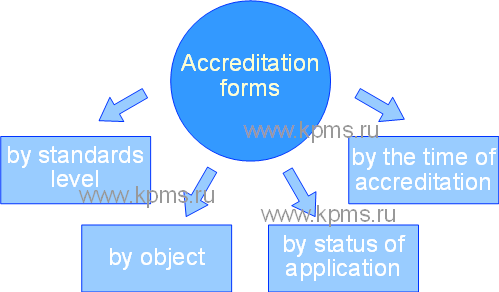
The forms of accreditation may different based on these factors:
- according to the level of accreditation standards;
- by objects of accreditation;
- by the status of the application of accreditation;
- according to the time of accreditation.
The forms of accreditation according to the level of standards are associated with the region of the standards and, accordingly, the region of accreditation. Standards can be applied at the international, national, regional or local levels. Also, standards may belong to certain associations (for example, SRO standards) or organizations (for example, JCI standards).
The forms of accreditation are distinguished in accordance with the affiliation of the standards:
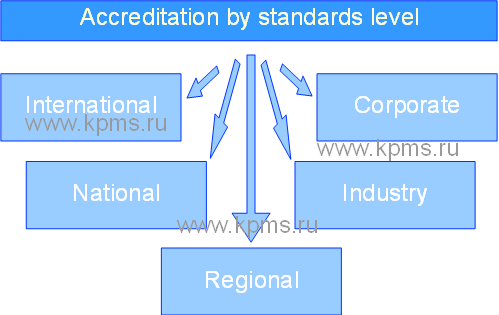
- international accreditation. This form of accreditation is carried out for compliance with international standards. The results of accreditation are recognized by participants of economic activity from different countries of the world. An important condition with this form of accreditation is not only compliance with the international standard, but also recognition of the results of accreditation in various countries. If there is no such recognition, then the accreditation cannot be considered international;
- national accreditation. Such accreditation is carried out at the level of individual States. Almost all countries of the world have their own national accreditation systems. Both national and international standards can act as accreditation standards. The results of accreditation in the national accreditation system are recognized only within this State. However, if there is an agreement on mutual acceptance (Multilateral Recognition Arrangement) of the results of accreditation between the national accreditation systems of different countries, then accreditation in the national system "automatically" receives the status of international accreditation;
- regional accreditation. Accreditation is carried out for compliance with regional standards in this case. As a rule, such accreditation is associated with the activities of enterprises and organizations located within the same region. The results of the accreditation are recognized by the participants of the economic activity of this particular region. It should be noted that the concept of "region" is quite extensive. It may be limited to a single city, or it may be limited to several countries (for example, the system of accreditation of higher education in the Asia-Pacific region). However, to a greater extent, this form of accreditation refers to "small" geographical dimensions;
- industry accreditation. Many directions of economic activity have their own accreditation. It is related to the specifics of work in this particular industry (for example, accreditation of educational institutions, accreditation of auditors, etc.). This form of accreditation implies the existence of industry standards of activity. Acceptance of the results of accreditation can exist at different levels: international, national or regional. It depends on the existence of agreements between the participants of economic activity in a particular industry;
- corporate accreditation. In many countries, legislation allows the creation of accreditation systems for enterprises or even individuals. A corporate form of accreditation is possible in this case. The types of activities for which it is possible to create corporate accreditation may be restricted by law. Both the company's own standards (standards of the enterprise) and national or international standards are used as accreditation standards. The application of own standards is widely developed in the automotive industry. Well-known automakers develop their own standards and carry out accreditation of suppliers according to these standards.
In addition to the "pure" forms of accreditation, there may be a mixed one. For example, industry accreditation will be of an international if the participants of the accreditation system are companies (persons) from different countries of the world and there is an agreement between them on mutual recognition of accreditation.
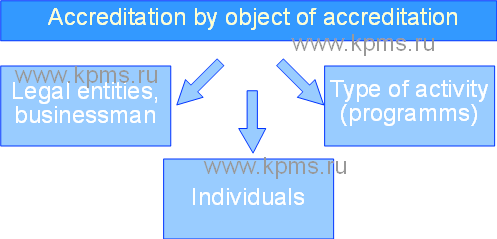
The forms of accreditation for the objects of accreditation are related to the legal status of applicants (organizations or persons wishing to obtain accreditation).
There are two main forms of accreditation on this basis:
- accreditation of organizations (legal entities, businessman);
- accreditation of individuals (experts, specialists, etc.).
Legal entities and businessmen may be accredited in various accreditation systems related to the affiliation of standards (for example, legal entities may have international, national, etc. accreditation). However, the type of activity is still affected by the accreditation of legal entities and businessman.
Another accreditation option that can be attributed to this form of accreditation is the accreditation of the type of activity. The type of activity is understood as any service or type of work. For examples it can be educational programs, medical services, programs for information systems. In this case, accreditation is not received by a legal entity or a businessman, but a set of organizational and methodological measures.

Forms of accreditation by application status have two options:
- mandatory accreditation;
- voluntary accreditation.
Mandatory accreditation is regulated and carried out by state bodies. This form of accreditation is directly related to the health and safety of citizens and the state. For example, the mandatory form of accreditation applies to works in the field of nuclear energy, works related to air, sea and river transportation, ensuring the sanitary and hygienic well-being of citizens, etc.
The voluntary form of accreditation is used where there is no direct threat to the safety and health of citizens and the state. Regulation of this area by the state exists, but it is limited by the level of laws, the establishment of rules, norms and principles of accreditation.
The difference between voluntary and mandatory forms of accreditation can be expressed as follows:
- an organization (or a businessman) independently decides on accreditation in the case of a voluntary form of accreditation. An organization ( or a businessman) can engage in the chosen type of activity regardless of the availability of accreditation;
- an organization (or a businessman) cannot engage in the chosen type of activity without accreditation with a mandatory form of accreditation. If an organization (businessman) is engaged in the chosen type of activity without accreditation, then such activity will be considered illegal and prosecuted under criminal or administrative law.

The forms of accreditation may vary in periods. It may be indefinite or have a limited validity period depending on the rules established in the accreditation system. The presence of indefinite accreditation does not mean that after receiving it, the organization (businessman) will not be monitored. As a rule, periodic verification of compliance with the accreditation criteria is carried out after receiving accreditation (both urgent and indefinite). If an organization or businessman violates the requirements and criteria of accreditation, the accreditation will be canceled. If an organization or businessman violates the requirements and criteria of accreditation, the accreditation will be canceled.
Accreditation system
The accreditation system is a set of organizational, documentation and technical elements that interact with each other to increase mutual trust in the works and services of the system participants and achieve the goals of accreditation.
It follows from this definition that any accreditation system has:
- the purpose for which the accreditation system is being created;
- organizational, documentation and technical elements that ensure the operation of the accreditation system;
- system participants who interact with each other and with elements of the accreditation system;
- works and services that are performed either by the participants of the system themselves, or are performed for the participants of the accreditation system.
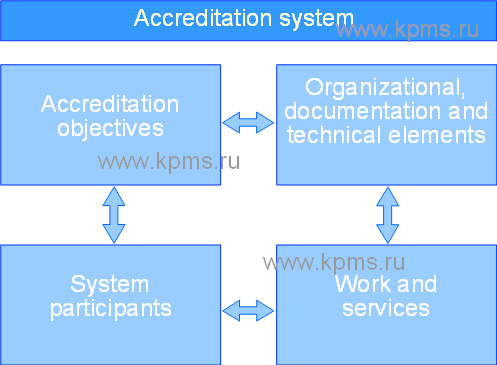
As a rule, the purpose for which the accreditation system is created is to increase the confidence of the system participants, but depending on the orientation of the system and the types of activities, it may be specified. For example, the detailed objectives of accreditation will differ in the education system and in the oil and gas industry.
The organizational, documentation and technical elements of the accreditation system include various regulations, rules, norms, standards and registers of the accreditation system. These elements can be their own, or they can be borrowed from other systems in each accreditation system. The standards for compliance with which accreditation is carried out are most often borrowed. Therefore, accreditation systems may be different, but the standards applied in them are the same. For example, there are many national accreditation systems. International standards are used as accreditation standards in these systems.
The participants of the system may vary in composition depending on the form of accreditation. The minimum membership of the accreditation system includes the accreditation body, the applicant's organizations or accredited persons and accreditation experts in this system. Experts can be both organizations and individuals. The higher the "level" of the system, the greater the number of participants (by type) it includes.
The works and services included in the accreditation system can be divided into two types. The first type is works and services for accredited activities. For example, if an accreditation system in construction is being created, then various types of construction works and services may be included here. The second type is the work and services to ensure the functioning of the accreditation system. These types of work include, for example, work on accreditation, on maintaining a register of accredited organizations, on periodic inspection of organizations, etc.
Accreditation criteria
The accreditation criteria are a set of requirements and rules that are part of the documentation elements of the accreditation system. These criteria determine the minimum set of actions that applicants must perform if they want to be accredited in a particular system.
The accreditation criteria will be different in different accreditation systems. Accreditation systems can be ranked by "prestige" depending on the complexity of the criteria. Accreditation obtained in a system with a higher level of requirements creates greater confidence on the part of economic activity participants.
The criteria for accreditation can be general and particular. General accreditation criteria are usually established at the level of laws. The general criteria set the basic requirements for accreditation. Particular criteria are established in by-laws (for a mandatory form of accreditation) or in the rules of the accreditation system (for a voluntary form of accreditation). Particular accreditation criteria detail the composition of the requirements that applicants must fulfill for accreditation for a specific type of activity.
The criteria for accreditation at the stage of obtaining accreditation and at the stage of confirming accreditation may differ in some systems. For example, the criteria may be more "easy" when obtaining accreditation than when it is confirmed after a certain period of work within this system.
Certificate of accreditation
The certificate of accreditation is required to confirm the successful completion of the accreditation procedure by the applicant. In addition, the certificate of accreditation confirms that the applicant (accredited person) belongs to one or another accreditation system.
The content of the accreditation certificate varies in different systems, but the minimum set of data indicated in it is well-established in all accreditation systems.
Such a data set includes:
- name of the accreditation system. It allows you to divide the systems among themselves and identify the affiliation of participants to a particular system;
- the name of the organization (or state body) that issued the certificate of accreditation. If there are several organizations authorized to issue accreditation in the system, then this element of the accreditation certificate allows you to control the affiliation of accreditation certificates;
- the name of the organization (person) that received the accreditation. This detail indicates that the applicant has successfully passed accreditation in the selected accreditation system;
- the name of the types of accreditation activities. This prop of the accreditation certificate establishes the areas of work for which the applicant can carry out his activities. Types of activities can be indicated either by listing their names, or by listing the standards in which this activity is regulated;
- date of issue and expiration date. They allow you to determine the relevance and suitability of the accreditation certificate;
- the identification number of the accreditation certificate. It establishes a unique certificate number and a unique entry number in the register of accredited persons;
- accreditation mark. As a rule, each accreditation system has its own unique accreditation mark. It is necessary to visually highlight a specific accreditation system among other accreditation systems.
Additional details of the accreditation certificate may be signatures and seals of organizations, various elements of protection against forgery of accreditation certificates.
Accreditation mark
The applicant receives an accreditation certificate and an accreditation mark after successful completion of accreditation. The accreditation mark is used for marketing purposes in most cases. A person who has received accreditation may use the mark of the accreditation system to distinguish his activities among other participants in economic relations.
There are rules for applying the accreditation mark in all accreditation systems. The accredited person must comply with these rules after receiving accreditation. Different systems have their own rules for applying the accreditation mark. These rules depend on the types of accredited activities and objects of accreditation.
The use of the accreditation mark in most systems is voluntary. An organization or a person who has received accreditation has the right to decide whether to apply the accreditation mark or not. If a person refuses to apply the accreditation mark, then quite often, the accreditation rules indicate the need to inform the accreditation body about it.
